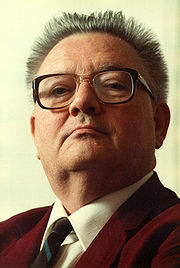
Edwin Thompson Jaynes
Encyclopedia

St. Louis, Missouri
St. Louis is an independent city on the eastern border of Missouri, United States. With a population of 319,294, it was the 58th-largest U.S. city at the 2010 U.S. Census. The Greater St...
. He wrote extensively on statistical mechanics
Statistical mechanics
Statistical mechanics or statistical thermodynamicsThe terms statistical mechanics and statistical thermodynamics are used interchangeably...
and on foundations of probability
Probability
Probability is ordinarily used to describe an attitude of mind towards some proposition of whose truth we arenot certain. The proposition of interest is usually of the form "Will a specific event occur?" The attitude of mind is of the form "How certain are we that the event will occur?" The...
and statistical inference
Statistical inference
In statistics, statistical inference is the process of drawing conclusions from data that are subject to random variation, for example, observational errors or sampling variation...
, initiating in 1957 the MaxEnt interpretation
Maximum entropy thermodynamics
In physics, maximum entropy thermodynamics views equilibrium thermodynamics and statistical mechanics as inference processes. More specifically, MaxEnt applies inference techniques rooted in Shannon information theory, Bayesian probability, and the principle of maximum entropy...
of thermodynamics, as being a particular application of more general Bayesian
Bayesian inference
In statistics, Bayesian inference is a method of statistical inference. It is often used in science and engineering to determine model parameters, make predictions about unknown variables, and to perform model selection...
/information theory
Information theory
Information theory is a branch of applied mathematics and electrical engineering involving the quantification of information. Information theory was developed by Claude E. Shannon to find fundamental limits on signal processing operations such as compressing data and on reliably storing and...
techniques (although he argued this was already implicit in the works of Gibbs
Josiah Willard Gibbs
Josiah Willard Gibbs was an American theoretical physicist, chemist, and mathematician. He devised much of the theoretical foundation for chemical thermodynamics as well as physical chemistry. As a mathematician, he invented vector analysis . Yale University awarded Gibbs the first American Ph.D...
). Jaynes strongly promoted the interpretation of probability theory
Probability theory
Probability theory is the branch of mathematics concerned with analysis of random phenomena. The central objects of probability theory are random variables, stochastic processes, and events: mathematical abstractions of non-deterministic events or measured quantities that may either be single...
as an extension of logic
Logic
In philosophy, Logic is the formal systematic study of the principles of valid inference and correct reasoning. Logic is used in most intellectual activities, but is studied primarily in the disciplines of philosophy, mathematics, semantics, and computer science...
.
In 1963, together with Fred Cummings
Fred Cummings
Fred Cummings is a theoretical physicist and professor emeritus at University of California, Riverside. He specialises in cavity quantum electrodynamics, many-body theory and non-linear dynamics.-Discoveries:...
, he modeled
Scientific modelling
Scientific modelling is the process of generating abstract, conceptual, graphical and/or mathematical models. Science offers a growing collection of methods, techniques and theory about all kinds of specialized scientific modelling...
the evolution of a two-level atom
Two-level system
In quantum mechanics, a two-state system is a system which has two possible states. More formally, the Hilbert space of a two-state system has two degrees of freedom, so a complete basis spanning the space must consist of two independent states...
in an electromagnetic field, in a fully quantized way. This model is known as the Jaynes–Cummings model.
A particular focus of his work was the construction of logical principles for assigning prior probability
Prior probability
In Bayesian statistical inference, a prior probability distribution, often called simply the prior, of an uncertain quantity p is the probability distribution that would express one's uncertainty about p before the "data"...
distributions; see the principle of maximum entropy
Principle of maximum entropy
In Bayesian probability, the principle of maximum entropy is a postulate which states that, subject to known constraints , the probability distribution which best represents the current state of knowledge is the one with largest entropy.Let some testable information about a probability distribution...
, the principle of transformation groups and Laplace
Pierre-Simon Laplace
Pierre-Simon, marquis de Laplace was a French mathematician and astronomer whose work was pivotal to the development of mathematical astronomy and statistics. He summarized and extended the work of his predecessors in his five volume Mécanique Céleste...
's principle of indifference
Principle of indifference
The principle of indifference is a rule for assigning epistemic probabilities.Suppose that there are n > 1 mutually exclusive and collectively exhaustive possibilities....
.
Jaynes' last book, Probability Theory: The Logic of Science gathers various threads of modern thinking about Bayesian probability
Bayesian probability
Bayesian probability is one of the different interpretations of the concept of probability and belongs to the category of evidential probabilities. The Bayesian interpretation of probability can be seen as an extension of logic that enables reasoning with propositions, whose truth or falsity is...
and statistical inference
Statistical inference
In statistics, statistical inference is the process of drawing conclusions from data that are subject to random variation, for example, observational errors or sampling variation...
, and contrasts the advantages of Bayesian techniques with the results of other approaches. This book was published posthumously in 2003 (from an incomplete manuscript that was edited by Larry Bretthorst). An unofficial list of errata is hosted by Kevin S. Van Horn.
External links
- Edwin Thompson Jaynes. Probability Theory: The Logic of Science. Cambridge University Press, (2003). ISBN 0-521-59271-2.
- Early (1994) version (fragmentary) of Probability Theory: The Logic of Science. Book no longer downloadable for copyright reasons.
- A comprehensive web page on E. T. Jaynes's life and work.
- ET Jaynes' obituary at Washington university
- http://bayes.wustl.edu/etj/articles/entropy.concentration.pdf Jaynes' analysis of Rudolph Wolf's dice data

